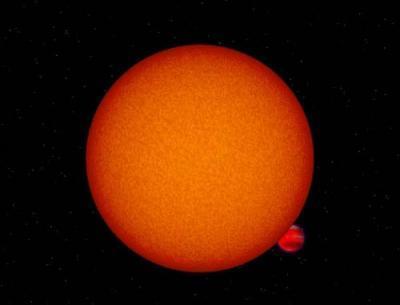For the first time this is a detector located on the surface of the earth and not in space

Two separate groups simultaneously succeeded in creating a thermal detector to locate planets outside the solar system. And for the first time, this is a detector located on Earth and not in space. To date, information regarding planetary atmospheres within the Milky Way has come from space observatories.
These new results, published in the journal Astronomy and Astrophysics, open a window to understanding external worlds and are especially important since most of the work has been done so far by the Spitzer Space Telescope. Spitzer will soon run out of cryogen and he will exhaust his abilities.
One team of researchers observed a planet known as OGLE-TR-56b, which is of the "hot Jupiter" type. Hot Jupiters are massive stars that orbit close to their parent star, completing a rotation cycle in two to three days. Since they are so close to the parent stars, they are hot enough to produce radiation in the visible and near infrared wavelengths and therefore can be detected from the Sun. The orbit of OGLE-TR-56b also continues behind the mother star, from the perspective of an observer on the surface of the Earth. What makes it difficult to see is that the star is pale and is in a compressed region, which is located towards the center of our galaxy, about 5000 light years from here.
"Others have tried to locate planetary atmospheres from DHA, but to no avail," notes one of the research leaders, Mercedes López Morales, from the Carnegie Institution, Department of Magnetism at DHA. "We managed to catch him on two different nights last summer. The recipe for success is a planet that emits a lot of heat and whose atmosphere has little or no winds. In addition to that, it should be a clear and calm night in DHA, so that we can accurately measure the difference of the heat emission in a normal state and during an eclipse, when the planet hides behind the mother star. About one in every 3,000 images yields data about the planet. The eclipse allows us to separate the emission from the planet and the emission from the star. The magical moment arrived on July 2nd from the Large Telescope of the European Southern Observatory (VLT) and on August 3rd from Carnegie's Magellan-Baad telescope in Chile." López Morales and his colleague Sarah Seeger had predicted even before that the ideal candidate for such a detection would be a planet with characteristics similar to OGLE-TR-56b.
The scientists obtained more than 600 images from the two telescopes. "Since this part of the galaxy is very dense and the planet is so pale, we needed these large telescopes," explains David Singh, one of the research leaders at the Institut d'Astrophysic de Paris. "The planet emits red light, as happens in a kitchen oven when it heats up, but we must know exactly when the eclipse is supposed to occur and measure the light flux from the star precisely in order to reduce it and reveal the thermal emission of the planet."
In the second study, published in the same journal article, astronomers in the Netherlands detected near-infrared thermal emission from an extrasolar planet known as TrES-3b. This discovery was also made from the ground. Information about the atmospheres of hot Jupiters from the Spitzer studies helped both groups of scientists. The warm Jupiters observed by Spitzer have similar atmospheric characteristics, particularly the thermal inversion, a phenomenon in which a warm layer holds a cold layer beneath it. "OGLE-TR-56b is hotter than anything Spitzer has seen so far," says López Marcels.
"At a temperature of more than 4400 degrees Fahrenheit, this is the hottest atmosphere ever measured for planets of this type. It is too hot to form clouds of silicon or iron, which cause the atmosphere to be dark - a common feature of hot planets that Spitzer studied. It is comforting to know that when Spitzer is out of use, studies like these two will continue to keep the field alive."
For the announcement of the Carnegie Institution for Science

4 תגובות
There is currently no ability to detect Earth-sized planets. It is hoped that space telescopes that will be launched in 4-5 years will solve the problem.
Joins the question of 1
Yes, provided it has aliens on it.
Is there a way to measure planets the size of DHA?